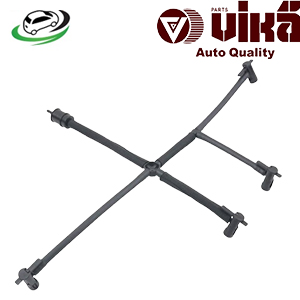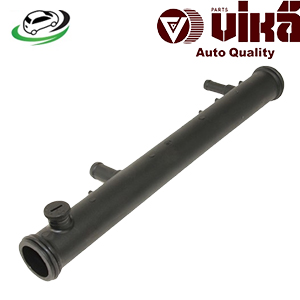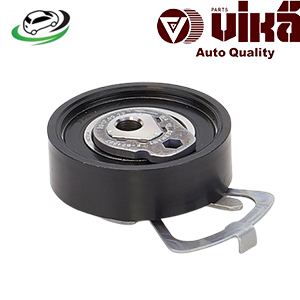-9%
Get AUDI A2 (8Z0) / VW Bora I (1J2)/ Golf IV (1J1)/ Golf V (1K1)/ Lupo I (6X1 6E1)/ Polo (6N2)/ Polo III (6N1)/ Polo V (6R1 6C1) Cambelt Tensioner 036109243AC
The cambelt tensioner is a mechanical device that maintains the proper tension on the timing belt, which connects the crankshaft to the camshaft(s). The tensioner ensures that the timing belt remains taut, preventing slippage or excessive wear. A properly functioning tensioner is essential for maintaining the timing belt’s integrity and the overall performance of the engine.
Types of Cambelt Tensioners:
- Mechanical Tensioners: These tensioners use a spring-loaded mechanism to maintain tension on the timing belt. They automatically adjust as the belt stretches over time.
- Hydraulic Tensioners: These utilize hydraulic pressure to maintain tension. They are often found in modern engines due to their precision and reliability.
2. Components of the Cambelt Tensioner
The cambelt tensioner consists of several key components, each playing a vital role in its operation:
1. Tensioner Pulley:
The tensioner pulley is a grooved wheel that guides the timing belt. It is mounted on a pivoting arm and helps maintain the correct tension on the belt.
2. Tensioning Arm:
This is the lever that pivots to apply tension to the belt. It is often spring-loaded or connected to a hydraulic actuator to ensure constant pressure.
3. Spring:
In mechanical tensioners, a spring is used to provide the necessary tension to the belt. It pushes against the tensioning arm, ensuring the pulley remains in contact with the belt.
4. Hydraulic Chamber:
In hydraulic tensioners, this chamber contains oil that allows for automatic adjustments to the tension based on the engine’s operating conditions.
5. Mounting Bracket:
The mounting bracket secures the tensioner to the engine block, providing stability and alignment for proper belt operation.
3. How the Cambelt Tensioner Works
The cambelt tensioner operates by maintaining the correct tension on the timing belt, which is critical for synchronizing the rotation of the crankshaft and camshaft(s). Here’s a step-by-step breakdown of its operation:
1. Initial Tensioning:
When the timing belt is installed, the tensioner applies initial tension to the belt. This is crucial for ensuring proper contact between the belt and the pulleys.
2. Dynamic Adjustment:
As the engine runs, the timing belt experiences wear and stretch due to continuous operation. The tensioner compensates for this by adjusting its position to maintain the correct tension.
- Mechanical Tensioners: The spring automatically adjusts the tension as needed.
- Hydraulic Tensioners: The hydraulic system allows for more precise adjustments based on the engine’s operating conditions, such as changes in speed and load.
3. Preventing Slippage:
By maintaining the proper tension, the tensioner prevents the timing belt from slipping. Slippage can lead to incorrect timing, causing serious engine damage.
4. Ensuring Smooth Operation:
A properly functioning tensioner contributes to the overall smooth operation of the engine, reducing noise and vibration associated with timing belt operation.
4. Benefits of a Cambelt Tensioner
The cambelt tensioner provides several significant benefits, all of which contribute to the overall performance and reliability of the engine:
1. Precise Timing Control:
The primary function of the tensioner is to maintain the correct tension on the timing belt, ensuring that the crankshaft and camshaft(s) remain perfectly synchronized. This is critical for optimal engine performance.
2. Extended Timing Belt Life:
By keeping the timing belt taut, the tensioner reduces the risk of premature wear and tear. A well-maintained tensioner can significantly extend the life of the timing belt, saving on replacement costs.
3. Improved Engine Efficiency:
Properly tensioned timing belts contribute to overall engine efficiency. They help the engine operate smoothly, improving fuel efficiency and power output.
4. Reduced Noise and Vibration:
A functioning tensioner minimizes noise and vibration caused by timing belt operation. This contributes to a quieter and more pleasant driving experience.
5. Preventing Engine Damage:
A malfunctioning tensioner can lead to timing belt slippage, which may cause the engine’s valves to collide with the pistons. This can result in catastrophic engine damage and expensive repairs. A working tensioner helps prevent such situations.
5. Common Issues with Cambelt Tensioners
While cambelt tensioners are generally reliable, they can experience several common issues that may affect their performance:
1. Wear and Tear:
Over time, the internal components of the tensioner can wear out, leading to reduced effectiveness. Mechanical tensioners may lose spring tension, while hydraulic tensioners can develop leaks.
2. Oil Leaks:
In hydraulic tensioners, leaks can develop due to wear or damage to the hydraulic chamber. Oil leaks can result in inadequate tension and timing belt slippage.
3. Noise:
A failing tensioner may produce unusual noises, such as rattling or squeaking. These noises can indicate that the tensioner or its components are worn or damaged.
4. Belt Misalignment:
If the tensioner is not functioning properly, it may cause the timing belt to become misaligned. This can lead to accelerated wear on the belt and pulleys.
5. Failure to Maintain Tension:
A tensioner that fails to maintain proper tension can result in timing belt slippage or jumping, leading to severe engine damage.
6. Maintenance of the Cambelt Tensioner
Proper maintenance of the cambelt tensioner is essential for ensuring its longevity and the smooth operation of the engine. Here are some key maintenance practices:
1. Regular Inspections:
Periodically inspect the cambelt tensioner for signs of wear, oil leaks, or unusual noises. This will help identify potential issues before they lead to serious problems.
2. Timing Belt Replacement:
When replacing the timing belt, it is recommended to replace the cambelt tensioner as well. A new belt may not function correctly with an old, worn tensioner.
3. Hydraulic Fluid Checks:
For hydraulic tensioners, ensure that the hydraulic fluid is at the correct level and that there are no leaks. This will help maintain proper tension.
4. Follow Manufacturer Recommendations:
Adhere to the manufacturer’s recommended maintenance schedule for the timing belt and tensioner. This typically includes regular inspections and replacements based on mileage or time intervals.
7. Replacement of the Cambelt Tensioner
If a cambelt tensioner is found to be faulty, it is essential to replace it promptly to avoid potential engine damage. Here’s a general overview of the replacement process:
1. Gather Necessary Tools and Parts:
Before starting, gather the required tools (wrenches, sockets, etc.) and ensure you have the correct replacement tensioner and timing belt.
2. Disconnect the Battery:
To prevent accidental electrical issues, disconnect the vehicle’s battery.
3. Remove the Timing Belt Covers:
Carefully remove the timing belt covers to access the timing belt and tensioner.
4. Loosen the Tensioner:
Using the appropriate tools, loosen the tensioner to relieve tension on the timing belt.
5. Remove the Timing Belt:
Carefully remove the timing belt from the pulleys, noting the routing for reinstallation.
6. Replace the Tensioner:
Remove the old tensioner and install the new one, ensuring it is properly aligned and securely mounted.
7. Reinstall the Timing Belt:
Reinstall the timing belt, following the manufacturer’s recommended routing. Adjust the tensioner to apply the correct tension to the belt.
8. Reassemble and Test:
Reinstall the timing belt covers and reconnect the battery. Start the engine and listen for any unusual noises, ensuring everything operates smoothly.
8. Conclusion
The cambelt tensioner is a vital component of the timing belt system, playing a crucial role in maintaining engine performance and longevity. By keeping the timing belt properly tensioned, the tensioner ensures that the engine’s timing remains accurate, preventing potential damage and improving fuel efficiency. Regular maintenance and timely replacement of the cambelt tensioner are essential for ensuring the overall health of the engine and avoiding costly repairs. By understanding the importance of the cambelt tensioner and its operation, vehicle owners can take proactive steps to ensure their engines run smoothly and efficiently.
Follow us on Facebook for more parts.




Reviews
Clear filtersThere are no reviews yet.